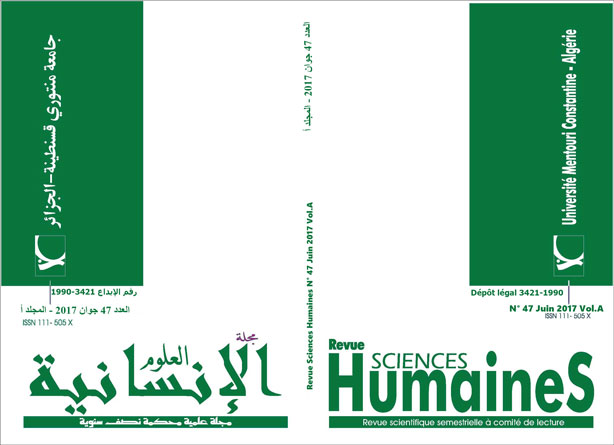Assessing ESP in 'Math Technique' Branches The Case of Civil Engineering BAC English Tests from 2010 to 2015
الكلمات المفتاحية:
ESP، Math Technique، Branches، Case، Civil Engineering، BAC، English Tests، 2010، 2015الملخص
In ESP testing, we are concerned with making inferences about the extent to which test takers can use language in contexts similar to their fields of study. In order to justify the score interpretations, and the purposes for which theyare intended to be used, two types of authenticity need to be provided. First, the pupils' instructional syllabus needs to correspond to language situations in specific target domains.Second, tests should sample their content and tasks from ESP relevant contexts. In this article, we attempt to conduct an empirical analysis to examine the extent to which these criteria are implementedin civil engineering specialties at the secondary school.التنزيلات
المراجع
Alderson, J. C. (2000a). Assessing Reading. Cambridge: Cambridge University Press.
Alderson, J. C.& Urquhart, A. (1985). The effect of students' academic discipline on their performance on ESP reading tests.Language Testing, 2, 192-204. From http://ltj.sagepub.com/cgi/content/abstract/2/2/192
Alderson, J. C., Clapham, C., & Wall, D. (1995).Language testing construction and evaluation. Cambridge: Cambridge University Press.
Bachman, L. F. (1990). Fundamental Considerations in Language Testing. Oxford: Oxford University Press.
Bachman, L. F. (1991). What does Language Testing Have to Offer? TESOL Quarterly, 25 (4), 671-704. http://www.jstor.org.www.sndl1.arn.dz/stable/pdfplus/3587082.pdf
Bachman, L. F., & Palmer, A. S. (1996).Language testing in practice.Oxford: Oxford University Press.
Basturkmen , H. (2010). Developing courses in English for specific purposes . Basingstoke, UK : Palgrave/Macmillan.
Basturkmen, H. (2006). Ideas and Options in English for Specific Purposes.Mahwah, NJ: L. Erlbaum Associates.
Basturkmen, H., & Elder, C. (2004).The practice of LSP. In A. Davies & C. Elder (Eds.), The handbook of applied linguistics (pp. 672–694). Oxford: Blackwell
Canale, M., & Swain, M. (1980). Theoretical bases of communicative approaches to second language teaching and testing. Applied Linguistics, 1(1), 1–47.
Dörnyei, Z. (1995). On the Teachability of Communication Strategies.TESOL quarterly 29( 1), 55 85. From http://www.jstor.org/stable/3587805
Dörnyei, Z., & Scott, L, M. (1997).Communication strategies in a second language:Definitions and taxonomies. Language Learning, 47 (1), 173-210. From
Douglas, D. (2000). Assessing Languages for Specific Purposes. Cambridge: Cambridge University Press.
Douglas, D. (2001). Three problems in testing language for specific purposes: Authenticity, specificity and inseparability. In C Elder et al (eds). Experimenting with uncertainty: Essays in honour of Alan Davies (pp. 45-51). Cambridge: Cambridge University Press.
Douglas, D. (2005). Testing Language for Specific Purposes.(2005).In H. Hinkel (ed.), Handbook of research in second language teaching and learning. (pp.857-868). Mahwah, NJ: London,, UK: Lawrence Erlbaum Associates Publishers.
Douglas, D.(2010a). Understanding Language Testing.London: Hodder Education.
Douglas, D.(2010b).This won’t hurt a bit: Assessing English for nursing.Taiwan International ESP Journal,2(2),1-16
Douglas, D.(2013). ESP and assessment. In B, Paltridge ., &Starfield, S. Eds.The handbook of English for specific purposes, (pp. 367-383). England, Chichester: John Wiley & Sons, Inc
Dudley-Evans, T., & St. John, M. (1998).Developments in English for Specific Purposes.Cambridge: Cambridge University Press.
Fulcher, G., & Davidson, F. (eds) (2012). The Routledge Handbook of Language Testing (pp. 455- 468). Abingdon, Oxon: Routledge.
Fulcher, G. (2010). Practical language testing.London, UK: Hodder Education.
Harris, M, C.(2006).The dictionary of architecture and construction(4thed). New York: McGraw-Hill Companies, Inc,
Heidenreich, S. (2008).English for Architects and Civil Engineers.Auflage: Der Vieweg+TeubnerVerlag
Hyland, K. (2006) English for academic purposes: An advanced resource book (London: Routledge).
Hymes, D. (1972). On communicative competence. In J. Pride & J. Holmes (Eds.), Sociolinguistics (pp. 269–293). Harmandsworth, UK: Penguin.
Jupp, V. (2006).Documents and Critical Research. In J Sapsford.,& V, Jupp (Eds). Data collection and analysis (2nded, pp.272-290). London: SAGE Publications; The Open university.
Messick, S. (1995).Validity of psychological assessment: Validation of inferences from persons' responses and performances as scientific inquiry into score meaning.American Psychologist, 50 (9)741-749
Ministry of Education.(2014-2015a). New Prospects: Pupils' Course book. Alger: OPS
Ministry of Education.(2014-2015b). New Prospects: Teachers' book. Alger: OPS
Purpura, J. A.(2004). Assessing grammar. Cambridge: Cambridge University Press.
Savignon, S. J. (1972). Communicative competence: An experiment in foreign languageteaching.Philadelphia, PA: Center for Curriculum Development.
Savignon, S, J. (1991). Communicative Language Teaching: State of the Art.TESOLQuarterly, 25(2), 261-277. http://www.jstor.org.www.sndl1.arn.dz/stable/pdfplus/10.2307/3587463.pdf
Tarone, E. (1981). Some Thoughts on the Notion of Communication Strategy.TESOLQuarterly, 15 (3), 285-295. From http://www.jstor.org/stable/3586754 .












